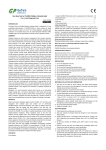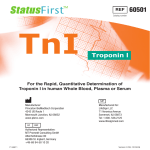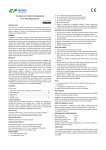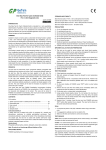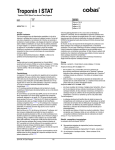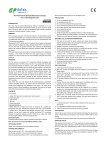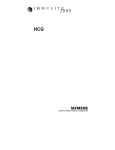Download User Manual
Transcript
APPLICABLE DEVICE Cardiac Troponin I Fast Test Kit For in vitro Diagnostic Use FIA8000 Quantitative Immunoassay Analyzer Cat.# CG1001 User Manual INTENDED USE STORAGE AND STABILITY Store the test card at 4~30℃ with a valid period of 24 months. Use the test card within 1 hour once the foil pouch is opened. Cardiac Troponin I Fast Test Kit is intended for in vitro qualitative and semi-quantitative determination of cardiac Troponin I (cTnI) in serum, plasma or whole blood. This test is used as an aid in the diagnosis of myocardial injury such as Acute Myocardial Infarction (AMI), Unstable Angina, Acute Myocarditis and Acute Coronary Syndrome (ACS). SUMMARY Troponin, a molecular complex that is bound to the thin filament (actin) of striated muscle fibers, acts with intracellular calcium to control the interaction of the thin filament with the thick filament (myosin), thus regulating muscle contraction. Troponin consists of three subunits: T, which connects the troponin complex and tropomyosin (another cardiac muscle regulatory protein); I, which prevents muscle contraction in the absence of calcium; and C, which binds calcium. Cardiac Troponin I (MW 22.5 kDa) and the two skeletal muscle isoforms of Troponin I have considerable amino acid sequence homology, but cTnI contains an additional N-terminal sequence and is highly specific for myocardium. Clinical studies have demonstrated the release of cTnI into the blood stream within hours following acute myocardial infarctions (AMI) or ischemic damage. Elevated levels of cTnI are detectable in blood within 4 to 6 hours after the onset of chest pain, reaching peak concentrations in approximately 8 to 28 hours, and remain elevated for 3 to 10 days following AMI. Due to the high myocardial specificity and the long duration of elevation, cTnI has become an important marker in the diagnosis and evaluation of patients suspected of having an AMI. The current guideline of The Joint European Society of Cardiology/American College of Cardiology Committee support the use of cTnI as a preferred marker of myocardial injury. Several major studies have shown that cTnI is also a predictor of cardiac risk in patients with unstable angina. The American College of Cardiology and the American Heart Association’s current guidelines recommend using troponin results when making treatment decisions regarding unstable angina and non-ST segment elevation MI (NSTEMI). PRINCIPLE The test uses an anti-human cTnI monoclonal antibody conjugated with colloidal gold and another anti-human cTnI monoclonal antibody coated on the test line. After the sample has been applied to the test strip, the gold-labelled anti-human cTnI monoclonal antibody binds with the cTnI in sample and forms a marked antigen-antibody complex. This complex moves to the test card detection zone by capillary action. Then marked antigen-antibody complex is captured on the test line by the anti-human cTnI monoclonal antibody resulting in a purplish red streak appears on the test line. The color intensity of the test line increases in proportion to the amount of cTnI in sample. CONTENTS A kit contains: 1. Getein cTnI test card in a sealed pouch with desiccant ····················25 2. Disposable pipet·······································································25 3. User manual ··········································································1 4. SD card ·················································································1 5. Whole blood buffer····································································1 A test card consists of: A plastic shell and a reagent strip which is composed of a sample pad, a colloid gold pad (coated with gold-labelled anti-human cTnI monoclonal antibody), nitrocellulose membrane (the test line is coated with anti-human cTnI monoclonal antibody, and the control line is coated with rabbit anti-mouse IgG antibody), absorbent paper and liner. Whole blood buffer composition: Phosphate buffered saline, proteins, detergent, preservative, stabilizer. Note: Do not mix or interchange different batches of kits. Store the whole blood buffer at 0~30℃ with a valid period of 24 months. Store the whole blood buffer at 2~8℃ for better results. PRECAUTIONS 1. 2. 3. 4. 5. 6. 7. 8. For in vitro diagnostic use only. For professional use only. Do not use the kit beyond the expiration date. Do not use the test card if the foil pouch is damaged. Do not open pouches until ready to perform the test. Do not reuse the test card. Do not reuse the pipet. Handle all specimens as potentially infectious. Proper handling and disposal methods should be followed in accordance with local regulations. 9. Carefully read and follow user manual to ensure proper test performance. SPECIMEN COLLECTION AND PREPARATION 1. This test can be used for serum, plasma and whole blood samples. Heparin can be used as the anticoagulant for plasma and whole blood. Samples should be free of hemolysis. 2. Suggest using serum or plasma for better results. 3. Serum or plasma can be used directly. For whole blood sample, one drop of whole blood buffer must be added before testing. 4. If testing will be delayed, serum and plasma samples may be stored up to 7 days at 2~8℃ or stored at -20℃ for 6 months before testing(whole blood sample may be stored up to 3 days at 2~8℃). 5. Refrigerated or frozen sample should reach room temperature and be homogeneous before testing. Avoid multiple freeze-thaw cycles. 6. Do not use heat-inactivated samples. 7. SAMPLE VOLUME: 120 μl. TEST PROCEDURE 1. Collect specimens according to user manual. 2. Test card, sample and reagent should be brought to room temperature before testing. 3. Confirm SD card lot No. in accordance with test kit lot No.. Perform “QC (SD)” calibration when necessary (Details refer to 8.2.1 of FIA8000 User Manual). 4. On the main interface of FIA8000, press "ENT" button to enter testing interface. 5. Remove the test card from the sealed pouch immediately before use. Label the test card with patient or control identification. 6. Put the test card on a clean table, horizontally placed. 7. Using sample transfer pipette, deliver 120 μl of sample (or 4 drops of sample when using disposable pipet) into the sample port on the test card (for whole blood sample, one drop of whole blood buffer must be added after loading 120 μl sample on the test card). 8. Reaction time: 15 minutes. Insert the test card into FIA8000 and press "ENT" button after reaction time is elapsed. The result will be shown on the screen and printed automatically. Notes: 1. It is required to perform “QC (SD)” calibration when using a new batch of kits. 2. It is suggested to calibrate once for one batch of kits. 3. Make sure the test card insertion is correct and complete. TEST RESULTS Valid: When a purplish-red band appears at the control area(C), use FIA8000 to analyze the test card and get the result. Invalid: If no colored band appears in the control area (C), the test result is invalid. The test should be repeated and if the same situation happened again, please stop using this batch of products and contact your supplier. EXPECTED VALUE DESCRIPTION OF SYMBOLS USED The expected normal value for cTnI was determined by testing samples from 500 apparently healthy individuals. The 99th percentile of the concentration for cTnI is 0.5 ng/ml. cTnI concentration less than 0.5 ng/ml can be estimated as normal. It is recommended that each laboratory establish its own expected values for the population it serves. The following graphical symbols used in or found on Cardiac Troponin I Fast Test Kit are the most common ones appearing on medical devices and their packaging. They are explained in more details in the European Standard EN 980:2008 and International Standard ISO 15223-1:2007. Key to symbols used PERFORMANCE CHARACTERISTICS Measuring Range 0.5~50.0 ng/ml Lower Detection Limit ≤ 0.5 ng/ml Within-Run Precision (n=10) ≤10% Between-Run Precision ≤15% Recovery 95% (mean) Method Comparison: The assay was compared with SIEMENS IMMULITE 2000 and its matching cTnI test kits with 200 serum samples (60 positive samples and 140 negative samples). The correlation coefficient (r) for cTnI is 0.952. LIMITATIONS 1. As with all diagnostic tests, a definitive clinical diagnosis should not be made based on the result of a single test. The test results should be interpreted considering all other test results and clinical information such as clinical signs and symptoms. 2. Samples containing interferents may influence the results. The table below listed the maximum allowance of these potential interferents. Interferent Hemoglobin Triglyceride Bilirubin Concentration (Max) 5 g/L 10 g/L 0.2 g/L REFERENCES 1. Mauro Pantaghini; Undefined International Federation of Clinical Chemistry and Laboratory Medicine (IFCC).Scientific Division Committee on Standardization of Markers of Cardiac Damage. Clin Chem Lab Med, 1998, 36: 887~893. 2. Antman EM, Anbe DT, Armstrong PW, et al. ACC/AHA guidelines for the management of patients with ST-elevation myocardial infarction: a report of the American College of Cardiology/American Heart Association Task Force on Practice Guidelines (Committee to Revise the 1999 Guidelines for the Manage 2004). 3. EN ISO 18113-1:2009 In vitro diagnostic medical devices - Information supplied by the manufacturer (labelling) - Part 1: Terms, definitions and general requirements. 4. EN ISO 18113-2:2009 In vitro diagnostic medical devices - Information supplied by the manufacturer (labelling) - Part 2: In vitro diagnostic reagents for professional use (ISO 18113-2:2009). Manufacturer Expiration date Do not reuse Date of manufacture Consult instructions for use Batch code Temperature limitation In vitro diagnostic medical device Sufficient for Authorised representative in the European Community CE mark Thank you for purchasing Cardiac Troponin I Fast Test Kit. Please read this user manual carefully before operating to ensure proper use. Version: WCGDL-SM-01-01 GeTein BioMedical Inc. 4640 SW Macadam Avenue, Suite 130C; Portland, OR 97239, USA Tel: 1-971-407-3868 Fax: 1-971-407-3868 E-mail: [email protected]; [email protected] Website: http://www.geteinbio.com


